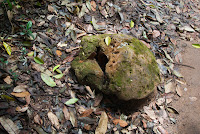Our first full day in Saigon was a relaxing one. Since we arrived after dark the night before, we enjoyed getting acquainted with the city and planning sightseeing trips. Here are views of the city and the street below taken from our fourth-floor hotel window.
Just opposite the hotel is the New Pearl Restaurant...a great spot for breakfast, cocktails and dinner.
John and I decided that the traffic in Saigon is as bad, if not worse than in Phnom Penh. We ventured out, but tried to find a group of locals so we could tag along as we crossed the streets.
The following morning, John and I, Jimmy and Nine were joined by friends Steve and Liz from our tour group. Along with a guide and driver, we toured the infamous Cu Chi tunnels approximately 70 kilometers outside Saigon. The tunnels are part of a vast network of underground passages, including living quarters, medical facilities and former weapons caches. They are located at the end of the Ho Chi Minh Trail and were used by the Viet Cong guerrillas during the Vietnam War.
When I say "toured" it's a misnomer. The tunnels were barely large enough to allow us to pass single file. And at some places we had to bend double to get through. We were told that the section open to tourists has been enlarged to twice as wide and twice as high as originally built. Low-power lights have also been installed. Here is one of the tunnel entrances as it would have appeared during the war. It is almost invisible.
The following photos are examples of how smoke from cooking fires in the tunnels was dispersed, and how a ventilation tube would have been camouflaged.
We made our way through a section of the tunnels approximately 25 yards long, then exited at the first opportunity. The guidebook says, "NOTE: People with heart-complications or claustrophobia should not go through the tunnels. Going down and have some photos taken should be fine!" They weren't kidding. Here is a shot of Liz emerging from the tunnel complex.
The Cu Chi tour was interesting if propaganda-filled. Our guide was a former South Vietnamese communications officer and was well-versed in the country's history. Following the war, he spent three years in a "re-education camp" before he was released to continue with his life. He quietly told us that much of what we would see on the tour would be propaganda. He was right. The grounds around the tunnel complex had examples of the booby traps the VC employed during the war and displays dedicated to the "heroic" VC guerrillas
A disabled US tank was prominently displayed, and one stop on the tour was a post-Vietnamese War propaganda film. B-52 bomb craters were clearly marked.
The tour was a sobering look at part of our country's history than many would like to forget. However, all four of us either served or knew those who did, and we have a new respect for the sacrifices they made.
Upon our return to Saigon, we stopped for lunch at a small restaurant. Just as we finished our meal and began our city tour, the skies opened and the rain came down in torrents. As a result, we had to adjust our schedule somewhat and didn't get to visit everything we wanted.
After a while the skies cleared and we resumed our tour. Parts of Saigon are beautiful. Wide boulevards are decorated with large flowers, and the parks are carefully manicured. However, advertisements are everywhere and sometimes detract!
Saigon was not bombed during the Vietnam War. As a result, many of the beautiful old buildings, like the Notre Dame Cathedral, have been preserved,
We toured the War Remnants Museum (filled with more propaganda, as well as photographs from the War and a number of aircraft). The Reunification Palace was another tour stop, but we didn't go inside because of time constraints. Completed in 1966, it was built on the site of the former Norodom Palace, which was completed in 1873 and named for King Norodom of Cambodia. During the Vietnam War, the Palace was bombed and partially destroyed in an attempted coup against President Diem, and later rebuilt.
Another stop on our city tour was shop making and selling lacquer ware. The working conditions for the artisans were difficult at best.
However, the workmanship was remarkable. I especially liked the designs on these two pieces.
For our last night in Saigon, the six of us took a taxi to Ngon, a popular Vietnamese restaurant recommended by Liz and Steve's Lonely Planet guidebook. Similar to a restaurant we like in Phnom Penh, dishes are prepared at "kitchens" located on the restaurant's perimeter, each one responsible for a different dish or type of food.

Nine and I walked around to see what our culinary options were. We chose not to order the roast chicken.
We pigged out, said goodbye to Steve and Liz, and rolled into bed.





















The lacquer work is truly lovely and the working conditions are identical to those in Delores Hidalgo, Mexico, pottery shops. All the designs were hand done and the workers were in warehouses with no AC or heat & the workers were sitting on stools.
ReplyDelete